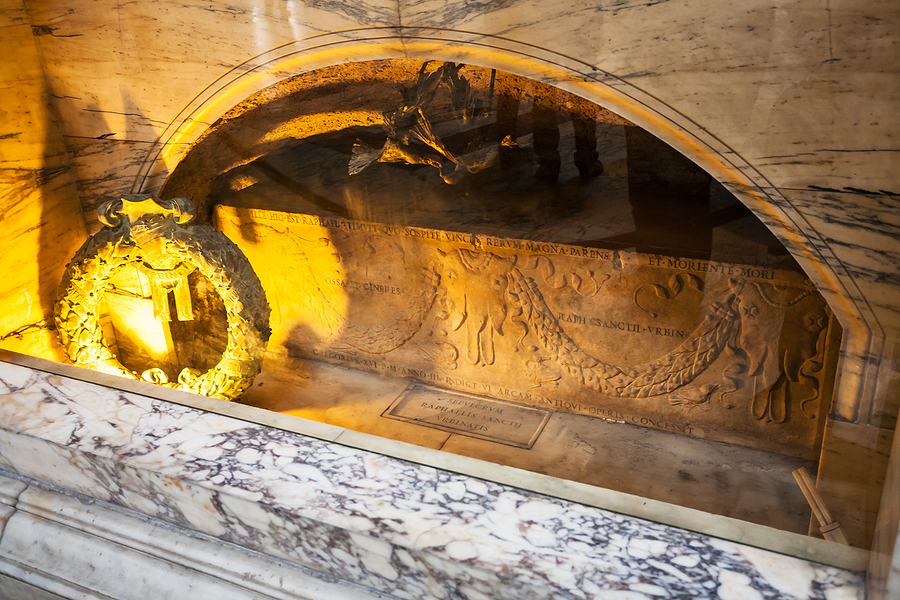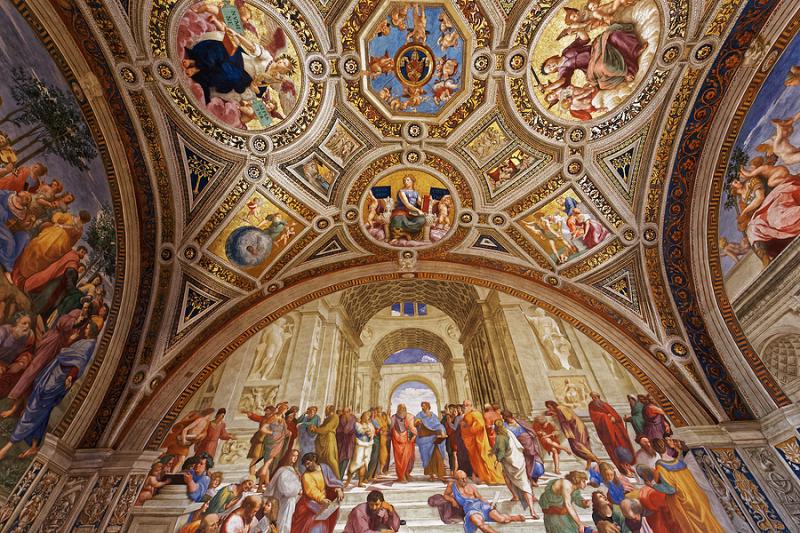To pay homage to Raphael on the 500th anniversary of his death, here’s a walking itinerary in the center of Rome to visit the places that contain his works or that were designed by the artist himself. This itinerary features well-known and lesser-knowns palaces and museums, so it’s a great chance to see Rome in an original way.
One day in 1508, Pope Julius II summoned two young artists in Rome: Michelangelo Buonarroti and Raffaello Sanzio da Urbino. He asked Michelangelo to paint the vault of the Sistine Chapel; and he asked Raffaello to fresco the walls of his private apartments in the Apostolic Palace. In doing so, Pope Julius II would profoundly influence the history of art in the years and centuries to come.
At only 25 years of age, Raphael had already acquired fame as an extraordinary artist, especially after his Florentine years (1504-1508). In the 12 years spent in Rome before his premature death, Raphael changed the course of art history.
His first group of works then was for the powerful and influential Pope Julius II. The four rooms he painted are part today of the Vatican Museums. The most famous of the four rooms, and also the first to be painted, is the Stanza della Segnatura, which contains the famous School of Athens fresco, whose allegorical meaning is that the first duty of man is knowledge.

[Details of fresco in Raphael's Rooms in the Vatican Museums.]
Overall, the four rooms represent, along with Michelangelo’s Sistine Chapel, the peak of the High Renaissance in Rome.
While you're at the Vatican Museums, consider that some of Raphael’s most famous frescoes are also preserved in the Pinacoteca Vaticana, an art gallery that is part of the museums complex. They include the ‘Coronation of the Virgin’, the Madonna of Foligno’, and the ‘Transfiguration’.
With the same ticket bought for the Vatican Museums, you have access to Villa Farnesina, in the heart of Trastevere, which is scheduled to host two exhibitions dedicated to Raphael: “Galatea e Psiche,” from October 6, 2020 to January 6, 2021; and “Raffaello e l'antico nella Villa di Agostino Chigi,” from March 25 to June 27, 2021.
In Rome, Raphael worked extensively for the rich Sienese banker Agostino Chigi, who built and lived in Villa Farnesina and asked Raphael to fresco the beautiful palace for him. The artist’s best known works are on the villa’s ground floor; the loggia contains “The Triumph of Galatea,” painted by Raphael in 1512, which recently led to the discovery of the color ‘Egyptian blue’, the world's first known synthetic pigment, recreated by the artist in his workshop and used to paint the sky and the sea of the fresco; and “Cupid and Psyche,” painted in 1518, symbolizing Chigi's love for his wife Francesca Ordeaschi, a Venetian courtesan.
Around the same time, Raphael designed for Chigi the architecture and mosaics of the dome of the Chigi chapel in the Basilica of Santa Maria del Popolo, completed in the following century by Gian Lorenzo Bernini. Chigi also commissioned to Raphael the frescoes of “Sibyls and Angels” on the upper arch of another family chapel, in the church of Santa Maria della Pace, inspired by Michelangelo's figures in the Sistine Chapel.

[Detail of Raphael's fresco in the Chigi Chapel in the Basilica of Santa Maria del Popolo.]
Between 1518 and 1519 Raphael painted “La Fornarina,” which is thought to be the portrait of his lover, Margherita Luti, the daughter of a baker from Trastevere; It is in the Galleria Nazionale d’Arte Antica in Palazzo Barberini, a beautiful place for the art lover, rich in works of art and masterpieces in the heart of Rome.
Another beautiful gallery that hosts works by Raphael is Galleria Borghese: “The Deposition of Christ” (1507), “Portrait of a Man” (c. 1502) and “Portrait of Young Woman with Unicorn” (c. 1506), the latter apparently inspired by the Mona Lisa, painted by Leonardo just a few years earlier. Leonardo was surely an influence on Raphael during his Florence years, as they lived in the city at the same time.
One of the last works by Raphael was the design of Villa Madama, commissioned by Pope Leo X, under the guidance of the powerful Cardinal Giulio de’ Medici; the elegant building is modeled after the ancient Roman villas, such as Villa Adriana in Tivoli and the Domus Aurea near the Colosseum.

[Raphael's tomb in the Pantheon.]
Perhaps the most fitting way to conclude an itinerary in Rome in the footsteps of Raphael is to head to the Pantheon, where the artist is buried, alongside other illustrious artists. On his tomb is an inscription in Latin by his friend Pietro Bembo, which reads, “Here lies that famous Raphael by whom Nature feared to be conquered while he lived, and when he was dying, feared herself to die.” That gives you an idea of the stature he had acquired in his short life, which only grew bigger with time. He was considered then, and still is today, and rightly so, one of the greatest artists of all time.
See also:
Raphael 2020: A 500th Anniversary Celebration of the Renaissance Artist









